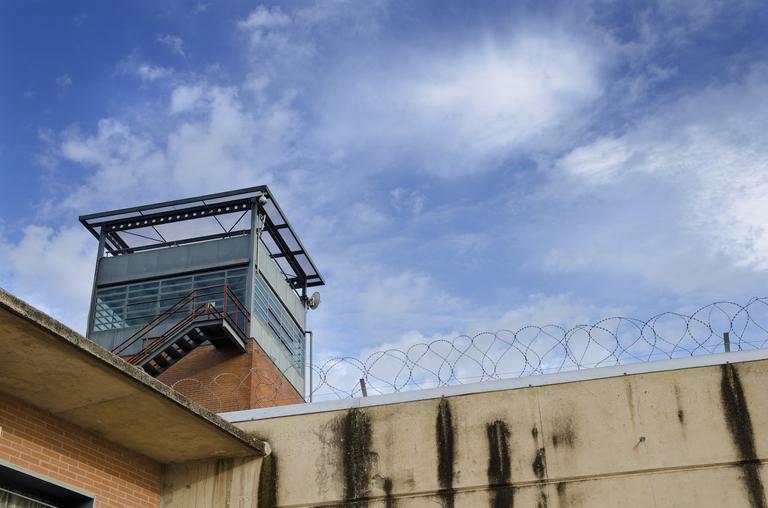
Criminal Justice
Kaitlyn Finley | September 27, 2019
A look back at criminal justice reform in Oklahoma
Kaitlyn Finley
At the turn of the century, many states’ prison populations and corrections expenditures continued to climb, despite falling crime rates. To combat this situation, in 2007 the Council of State Governments Justice Center created the Justice Reinvestment Initiative (JRI). This broad initiative sought to gather state correctional data with assistance from the Bureau of Justice Assistance, the U.S. Department of Justice, and The Pew Charitable Trusts to craft targeted criminal justice reform (CJR) policies, with collaboration from state policymakers. Thirty-five states, including Oklahoma, have participated in the Justice Reinvestment Initiative since its founding.
According to data from Pew, these states have passed significant CJR legislation, changing sentencing, pretrial policies, and parole. The Pew Charitable Trusts has outlined what broad measures have been adopted since JRI’s origin (see chart).
Oklahoma: CJR Timeline
In 2009, Oklahoma had the third-highest incarceration rate in the country and was dedicating a significant portion of state spending to corrections, with no slowdown in sight. With this in mind, some Oklahoma state officials saw a growing need to reform Oklahoma’s criminal justice system.
In 2011, Oklahoma policymakers collaborated with JRI to gather state correctional data and propose new reforms. During the following legislative session, in 2012, Oklahoma’s then- Governor Mary Fallin signed into law House Bill 3052 with the aim of lowering Oklahoma’s incarceration rate and safely reducing its nonviolent prison population.
House Bill 3052 created an intermediate revocation facility for temporary confinement of offenders who have violated the terms of their probation, increased post-release supervision of offenders, and mandated mental health and substance abuse screening for those convicted of a felony, as well as a few other reforms. However, the Oklahoma legislature faced difficulties securing funding for implementation of HB 3052, and some of these reforms were not in fact implemented.
In another push for criminal justice reform, Governor Fallin issued an executive order to create the Oklahoma Justice Reform Task Force in 2016. In their final report, issued in February 2017, the task force submitted 27 policy reforms to the legislature. Many of the policy recommendations focused again on strengthening post-release supervisions, focusing more corrections resources on violent offenders, and modifying sentencing for nonviolent crimes.
A handful of these recommendations passed the legislature and have been signed into law, such as the creation of administrative parole, which allows for a more streamlined parole process for certain nonviolent offenders (HB 2286, passed in 2018). Unfortunately, other bills recommended by the task force have stalled in the legislature in previous sessions. For instance, SB 421, proposed this past session by Sen. Stephanie Bice (R-Piedmont) and Rep. Garry Mize (R-Guthrie), would have clarified and standardized the criteria necessary for a drug possession and distribution conviction. The bill cleared the Senate but failed to pass in the House.
Past Policy Reforms
In the years since Oklahoma joined JRI, Oklahoma lawmakers, with approval from then-Governor Fallin and Governor Kevin Stitt, have passed more than 20 significant CJR measures aimed at reducing the state’s high incarceration rate. Below is a selection of key CJR measures signed into law.
- SJR (Senate Joint Resolution) 25: Granted a vote to the people to allow the Pardon and Parole Board to, in place of the governor, grant parole for nonviolent offenders. (Later passed as State Question 762 by Oklahoma voters on November 6, 2012).
- HB 3052: Created an intermediate revocation facility for offenders, mandated nine to twelve months of post-release supervision, required mental health and substance abuse screening for those convicted of a felony, and allowed for courts to modify an offender’s sentence for a select period of time with the district attorney’s approval.
- HB 1068: Established a procedure for those convicted of a violent felony crime (sentenced 25 years or more) to be able to file a motion requesting forensic DNA testing of biological material related to the original offense.
- Most pieces of criminal justice legislation dealt with strengthening penalties and punishment regarding human trafficking, domestic violence, and child abuse, as well as clarifying legal definitions in criminal codes related to these offenses. (See HB 2353, HB 2334, SB 1431).
- HB 1574: Removed the required life sentence for an offender’s “third strike” drug-related felony offense.
- HB 1518: “Justice Safety Valve Act.” Gave courts the discretion to depart from a minimum mandatory sentence (for nonviolent crimes) if the court found substantial reasons why the minimum mandatory sentence would not be deemed necessary for matters of public safety or other factors.
- HB 2751: Raised the threshold for property crimes to be charged as a felony to $1,000.
- HB 2753: Expanded eligibility for drug courts.
- HB 2472: Gave district attorneys the discretion to charge a person with a misdemeanor rather than a felony for certain crimes.
- HB 2479: Lowered punishment for those convicted of Schedule I or II drug possession from two to 10 years to now no more than five years.
- SB 603: Required the Department of Corrections to administer a personalized risk and needs assessment for each inmate for the purpose of reducing the inmate’s likelihood to reoffend.
- SB 342: Created a task force to assess current laws and specific policies relating to fines and fees in Oklahoma’s criminal justice system. The task force was directed to submit a report of findings and policy recommendations to the governor and legislature by November 30, 2019. However, the task force disbanded earlier this year after the creation of Governor Stitt’s criminal justice task force so as to not duplicate efforts.
- HB 2286: Established administrative parole. This parole procedure creates a streamlined consideration process for certain nonviolent offenders.
- HB 2286: Allowed consideration of parole for certain aging nonviolent offenders.
- SB 649: Removed the court’s ability to enhance punishment based on previous convictions for drug possession.
- SB 689: Authorized the court to modify nonviolent crimes for those serving life without parole if the offender has served at least 10 years and is not deemed a threat to public safety.
- SB 793: Removed life without parole as a sentencing option for those convicted of drug trafficking. The bill also lowered possible sentencing time from five to two years if convicted for possession of Schedule III, IV, V drugs or marijuana.
- HB 1269: Made State Question 780 retroactive and reclassified drug possession and certain property crimes as a misdemeanor instead of a felony.
- HB 1373: Scaled back restrictions that made it more difficult for former nonviolent offenders to obtain occupational licenses for employment.
- SB 694: Redirected fines and fees collected from defendants to a single general revolving fund for the state. Money from the revolving fund and additional appropriated dollars will now be distributed back to district courts and district attorneys, greatly reducing the financial incentive for district attorneys to collect fines and fees in order to fund their offices.
- HB 2765: Appropriated $33.3 million to support various diversion programs and expand drug court options for nonviolent offenders.
Policy Recommendations
Offer Earned Compliance Credits: Probation and Parole. Currently Oklahoma does not allow “good behavior” earned credits for those on parole or probation to go towards reducing the rest of their sentence. Improving compliance for probationers and parolees could have a substantial impact Oklahoma’s supervision resources and funding.
In their 2017 report, the Oklahoma Criminal Justice Task Force found that “more than half of probation revocations and 37 percent of parole revocations were for technical violations.” According to research compiled by The Pew Charitable Trusts, earned good behavior credits have been shown to increase compliance with supervision conditions.
Sixteen other states that have implemented earned compliance credits during probation and parole have seen positive results. For example, in 2008, the Arizona legislature passed the Safe Communities Act, which established earned time credits for offenders who complied with the terms of their probation or parole, and since then Arizona has seen a 29 percent decline in probation revocations to prison.
Modify ‘85 Percent Law’ for Nonviolent Offenses. Codified in 1999, Oklahoma lawmakers passed legislation which requires certain offenders to serve 85 percent of their sentences before they are eligible for parole. Most crimes on the “85 percent” list are serious violent offenses, including rape, first-degree murder, and child abuse; however, also included are aggravated drug trafficking and manufacturing. The 2017 task force report notes that those “sentenced to prison for drug crimes covered under the 85% statute… take up a significant amount of prison resources without commensurate public safety return.” Members of the task force recommended that those in the 85% category with nonviolent offenses, like drug trafficking, should be allowed to be transferred to electronic monitoring when 70 percent of their sentence has been served.
Standardize Oklahoma Drug Possession Laws. Current Oklahoma law is vague about what factors must be present for drug possession with the intent to distribute (PWID). This has raised concerns about inconsistent sentencing across Oklahoma’s counties. As noted earlier, SB 421 would have addressed these issues by clarifying what factors and how many factors, including possession of a firearm, large amounts of cash, and a few others, must be necessary to charge someone with PWID. This session, Oklahoma lawmakers should again consider approval of legislation like SB 421 in order to bring clarity to Oklahoma’s drug laws.
More Reforms to Come. Earlier this year, through executive order, Governor Stitt created the Criminal Justice Reentry, Supervision, Treatment and Opportunity Reform (RESTORE) Task Force. The 15-member panel, which began meeting in June, will meet throughout this fall and will “look to how to reduce Oklahoma’s incarceration rate, reduce the recidivism rate, and enhance and establish diversion programs,” according to the Stitt administration. The task force is set to provide specific recommendations to the Legislature by December 6, in time for the next legislative session.
Although Oklahoma lawmakers have passed a significant amount of notable legislation aimed at improving Oklahoma’s criminal justice system, it is clear that more reforms are necessary to continue to safely reduce the state’s high population of nonviolent offenders and lower its incarceration rate.

Kaitlyn Finley
Policy Research Fellow
Kaitlyn Finley currently serves as a policy research fellow for OCPA with a focus on healthcare and welfare policy. Kaitlyn graduated from the University of Science and Arts of Oklahoma in 2018 with a Bachelor of Arts in Political Science. Previously, she served as a summer intern at OCPA and spent time in Washington D.C. interning for the Heritage Foundation and the U.S. Senate Committee on Environment and Public Works.